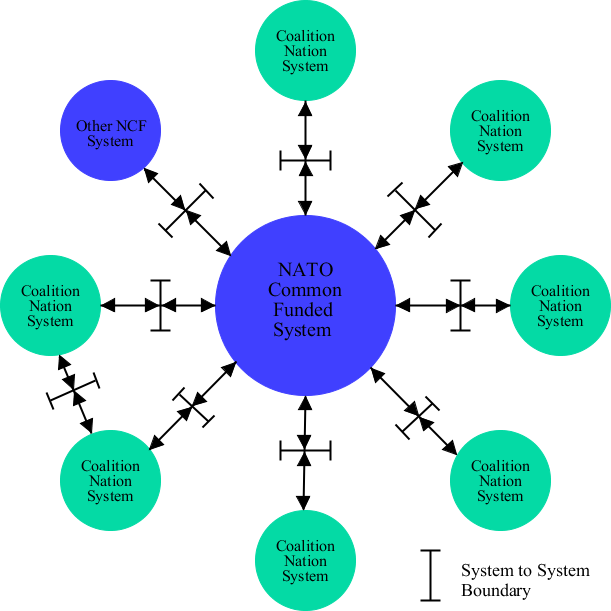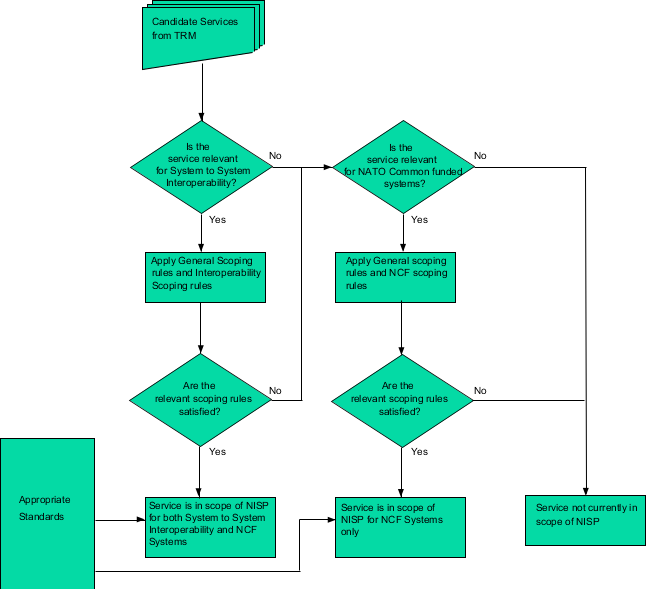1.2. NISP Scoping Principles
4. The services within the scope of the NISP are derived from the Compendium of NNEC Related Architectures to support the NNEC Networking and Information Infrastructure and the NNEC Capability areas. These services must be scoped for the inclusion in the NISP according to a defined process and set of scoping principles. The NISP has three primary aims:
-
To support interoperability between NCF systems, NII and the national CIS and NII belonging to coalition partners;
-
To deliver benefits to NCF systems by pursuing goals such as application accessibility, people portability and reduced training and through-life cost;
-
To support nation to nation interoperability. This can be achieved using the same boundary services and standards supported at the nation to NCF system and NII boundaries.
5. To support interoperability the NISP must define within its scope a set of services that can reasonably be mandated and supported (within the constraints of security) at the boundary between the systems or infrastructures. For example it is reasonable to mandate that web services should be exchanged using HTTP, but it is unreasonable (and untenable) to mandate that all nations should adopt Windows XP as their operating system or use a common programming language.
6. Consequently the standards specified for each service must be supported at the boundaries. These boundaries are referred to as a Interoperability Point (IOP). National systems may choose to use other standards internally and translate between the internal and boundary standards. For example, a nation may choose to use bitmap graphics internally but would be mandated to exchange JPEGs at the boundary. The interoperability model is shown diagrammatically below in Figure 1.1.
7. A benefit of this model is that by supporting the boundary services between national and NCF systems, services, and infrastructures, nation-to-nation interoperability will also be supported. Interface Point concepts are described further in NISP volume 1.

Figure 1.1. Interoperability Model
8. In order to achieve the primary aims of the NISP, the services derived from the NII must be categorized into those that are essential to support:
-
Interoperability at the boundary between systems or NII and must, therefore, be implemented by both coalition nation systems or NII and NCF systems or NII;
-
The wider goals of application accessibility, people flexibility, and reduced training; and
-
Through-life cost for NCF systems.
9. In simple terms, the interoperability services relate mainly to server-server interactions across the boundary between NCF systems or NII and national systems or NII. The NCF system or NII services, however, additionally include both server-server and client-server interactions within NCF systems.
10. Once the services have been categorized, it is then necessary to apply a set of scoping principles that will determine whether a service is within the scope of the NISP. The scoping principles can be subdivided into three groups:
-
A general set of scoping principles that are applied to all services;
-
An interoperability set of scoping principles that are applied to services that are shared between coalition nations, and between coalition nations and NCF Systems;
-
A set of scoping principles that only applies to NCF Systems or NII.
11. A simple flowchart of the process for scoping the services is shown in Figure 1.2. Once the services have been properly scoped into the NISP, the next step is to identify the standards that should be used to implement those services. Suitable justification should be provided as to the reason for each choice of standard.

Figure 1.2. Scoping Services
12. The ten key scoping principles are divided into three groups:
-
General scoping principles that are applicable to all candidate services
-
Standardization Requirement
-
Openness
-
Legacy Issues
-
Procurement Issues
-
-
Scoping principles applicable to System to System interoperability candidate services
-
System boundary issues
-
Interconnection security issues
-
System evolution
-
-
Scoping principles applicable to NATO Common Funded Systems (NCF) System candidate services (and which are not covered under interoperability)
-
Application Accessibility/Sharing (guaranteed interoperability by use of the same applications)
-
Reducing life-cycle costs
-
People flexibility and reduced training costs
-
13. Each of the ten scoping principles are elaborated and explained in the following sections.